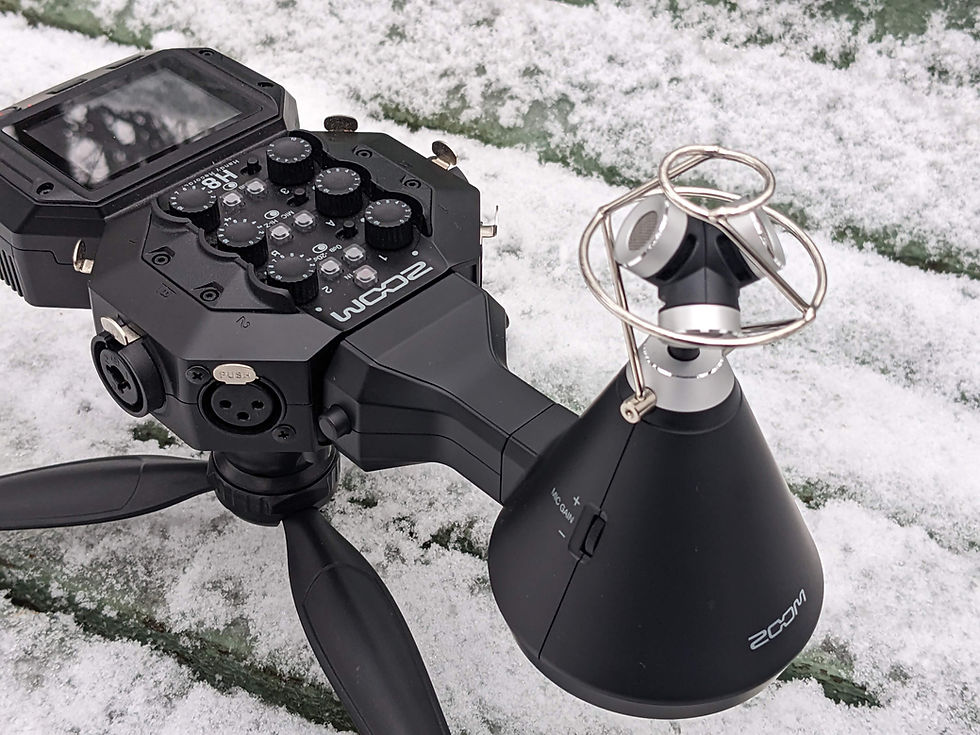Ambisonic microphone capsule VRH-8
- SignalAmbiant

- Feb 12, 2024
- 3 min read

The VRH8 capsule is one of the modular 2.0 capsules for the Zoom H8. In fact it is an adapted version of the H3VR for the H8 recorder. The version includes the microphone without the software which is managed directly via the H8 recorder. In line with the modular microphones released since the Zoom H6 there are 2 new microphone modules for the H8 (the 3rd module being an XLR socket extension) including the ambisonic module (VRH) and the stereo (XAH). VRH8 was the main reason at the time I got the H8 and skipped the H3VR at the time. I had heard a little about what the H3VR could do recording wise and the quality was very interesting for the price. In terms of preamps, they are not the quietest like the others in the Handy recorder range, but I like the principle of a multifunctional toolbox with the different microphone modules. I used the MS module on the H6 extensively and have made several good recordings since then with the various modules on that recorder.
When I started looking more seriously at getting an ambisonic microphone it was already in my list of options but due to the pandemic it took a long time before it was available on the market in Canada, so I had the time to purchase my Reynold ambisonic microphone well before receiving my VRH which I pre-order as soon as it was available.
Like the other items in Zoom's Handy Recorder series, the case is made of plastic. Some modules available for the H6 seem more sturdy, a mixture of plastic but also metal, I have the impression that over time the new module will wear and tear more easily.
The H8 is the only recorder at the moment that allows the use of this module because its software supports module 2.0 and multichannel recording. In terms of sound quality, having made comparative recordings with an H3VR and other ambisonic microphones (Sennheiser Ambeo and Reynolds Atype 4s), the sound of the VRH8 is identical to the H3VR. It sounds a little brighter and sound thinner than a high-end ambisonic microphone but for experimenting with ambisonic recording it's wonderful.
For the price, if we want to start experimenting with the ambisonic recording mode, the H8 and VRH8 combo allows us to make very good quality recordings and is a very portable and a lightweight kit. Going with the H8 mean you can also invest in other capsules from the Handy Recorder range, while the original H3VR only have one microphone.
Using the modular version you can also record with external microphones with the other inputs of the H8 which allows in total to record 10 tracks at the same time, 6 XLR on the H8 plus 4 tracks for the ambisonic microphone. So we could record double ambisonics and a stereo pair at the same time.
Positive:
Modular, if you already own the H8, cheaper than getting the H3VR if you want to do Ambisonic recording.
The quality and definition of the microphone is very good for the price.
Several multi-channel recording modes, Format A, B, Ambix, Fuma and stereo/Binaural
Automatic or user adjustment of microphone angle, Upright, Upside down and Endifre Inverted
Negative point :
The plastic build, the impression that it will break more easily than the old modules from the H6.
Sound a little brighter and thinner than several other ambisonic microphones on the market.
No VST plugins from Zoom to convert formats, although more and more options exist on the market to convert recordings to ambisonic format, having software made expressly for the microphone with its own characteristics would have been a plus. There is a player to listen to the recordings but no format conversion software.


Comments